Business Taxation: Trading Profits, Self-Employment, VAT Schemes
VerifiedAdded on 2022/12/29
|12
|3620
|37
AI Summary
This document provides an overview of business taxation, focusing on topics such as trading profits, self-employment, six badges for trade, and VAT schemes for different businesses. It explains the criteria for self-employment and discusses the various badges of trade. Additionally, it explores different VAT schemes and their implications for VAT registered companies.
Contribute Materials
Your contribution can guide someone’s learning journey. Share your
documents today.

Business
Taxation
Taxation
Secure Best Marks with AI Grader
Need help grading? Try our AI Grader for instant feedback on your assignments.
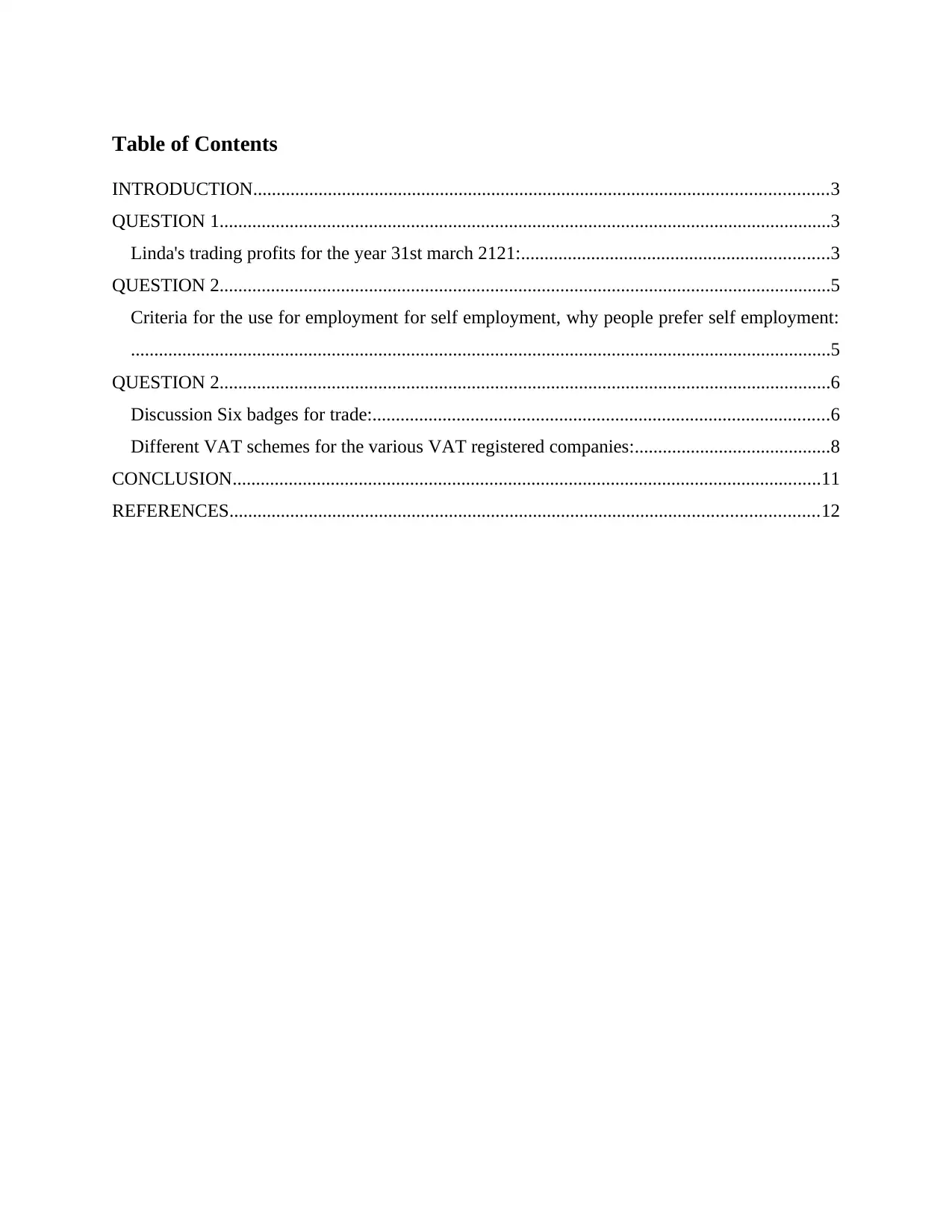
Table of Contents
INTRODUCTION...........................................................................................................................3
QUESTION 1...................................................................................................................................3
Linda's trading profits for the year 31st march 2121:..................................................................3
QUESTION 2...................................................................................................................................5
Criteria for the use for employment for self employment, why people prefer self employment:
......................................................................................................................................................5
QUESTION 2...................................................................................................................................6
Discussion Six badges for trade:..................................................................................................6
Different VAT schemes for the various VAT registered companies:..........................................8
CONCLUSION..............................................................................................................................11
REFERENCES..............................................................................................................................12
INTRODUCTION...........................................................................................................................3
QUESTION 1...................................................................................................................................3
Linda's trading profits for the year 31st march 2121:..................................................................3
QUESTION 2...................................................................................................................................5
Criteria for the use for employment for self employment, why people prefer self employment:
......................................................................................................................................................5
QUESTION 2...................................................................................................................................6
Discussion Six badges for trade:..................................................................................................6
Different VAT schemes for the various VAT registered companies:..........................................8
CONCLUSION..............................................................................................................................11
REFERENCES..............................................................................................................................12
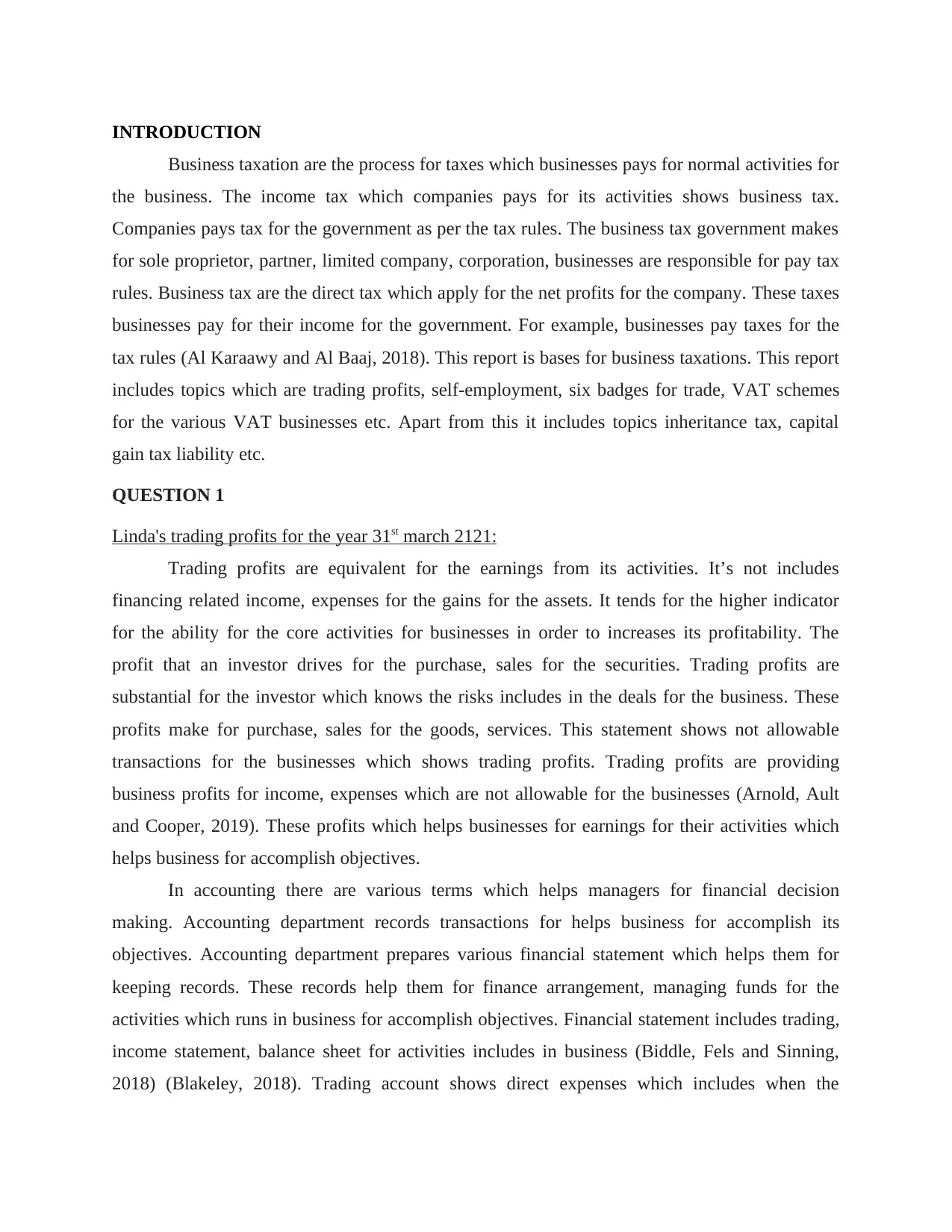
INTRODUCTION
Business taxation are the process for taxes which businesses pays for normal activities for
the business. The income tax which companies pays for its activities shows business tax.
Companies pays tax for the government as per the tax rules. The business tax government makes
for sole proprietor, partner, limited company, corporation, businesses are responsible for pay tax
rules. Business tax are the direct tax which apply for the net profits for the company. These taxes
businesses pay for their income for the government. For example, businesses pay taxes for the
tax rules (Al Karaawy and Al Baaj, 2018). This report is bases for business taxations. This report
includes topics which are trading profits, self-employment, six badges for trade, VAT schemes
for the various VAT businesses etc. Apart from this it includes topics inheritance tax, capital
gain tax liability etc.
QUESTION 1
Linda's trading profits for the year 31st march 2121:
Trading profits are equivalent for the earnings from its activities. It’s not includes
financing related income, expenses for the gains for the assets. It tends for the higher indicator
for the ability for the core activities for businesses in order to increases its profitability. The
profit that an investor drives for the purchase, sales for the securities. Trading profits are
substantial for the investor which knows the risks includes in the deals for the business. These
profits make for purchase, sales for the goods, services. This statement shows not allowable
transactions for the businesses which shows trading profits. Trading profits are providing
business profits for income, expenses which are not allowable for the businesses (Arnold, Ault
and Cooper, 2019). These profits which helps businesses for earnings for their activities which
helps business for accomplish objectives.
In accounting there are various terms which helps managers for financial decision
making. Accounting department records transactions for helps business for accomplish its
objectives. Accounting department prepares various financial statement which helps them for
keeping records. These records help them for finance arrangement, managing funds for the
activities which runs in business for accomplish objectives. Financial statement includes trading,
income statement, balance sheet for activities includes in business (Biddle, Fels and Sinning,
2018) (Blakeley, 2018). Trading account shows direct expenses which includes when the
Business taxation are the process for taxes which businesses pays for normal activities for
the business. The income tax which companies pays for its activities shows business tax.
Companies pays tax for the government as per the tax rules. The business tax government makes
for sole proprietor, partner, limited company, corporation, businesses are responsible for pay tax
rules. Business tax are the direct tax which apply for the net profits for the company. These taxes
businesses pay for their income for the government. For example, businesses pay taxes for the
tax rules (Al Karaawy and Al Baaj, 2018). This report is bases for business taxations. This report
includes topics which are trading profits, self-employment, six badges for trade, VAT schemes
for the various VAT businesses etc. Apart from this it includes topics inheritance tax, capital
gain tax liability etc.
QUESTION 1
Linda's trading profits for the year 31st march 2121:
Trading profits are equivalent for the earnings from its activities. It’s not includes
financing related income, expenses for the gains for the assets. It tends for the higher indicator
for the ability for the core activities for businesses in order to increases its profitability. The
profit that an investor drives for the purchase, sales for the securities. Trading profits are
substantial for the investor which knows the risks includes in the deals for the business. These
profits make for purchase, sales for the goods, services. This statement shows not allowable
transactions for the businesses which shows trading profits. Trading profits are providing
business profits for income, expenses which are not allowable for the businesses (Arnold, Ault
and Cooper, 2019). These profits which helps businesses for earnings for their activities which
helps business for accomplish objectives.
In accounting there are various terms which helps managers for financial decision
making. Accounting department records transactions for helps business for accomplish its
objectives. Accounting department prepares various financial statement which helps them for
keeping records. These records help them for finance arrangement, managing funds for the
activities which runs in business for accomplish objectives. Financial statement includes trading,
income statement, balance sheet for activities includes in business (Biddle, Fels and Sinning,
2018) (Blakeley, 2018). Trading account shows direct expenses which includes when the
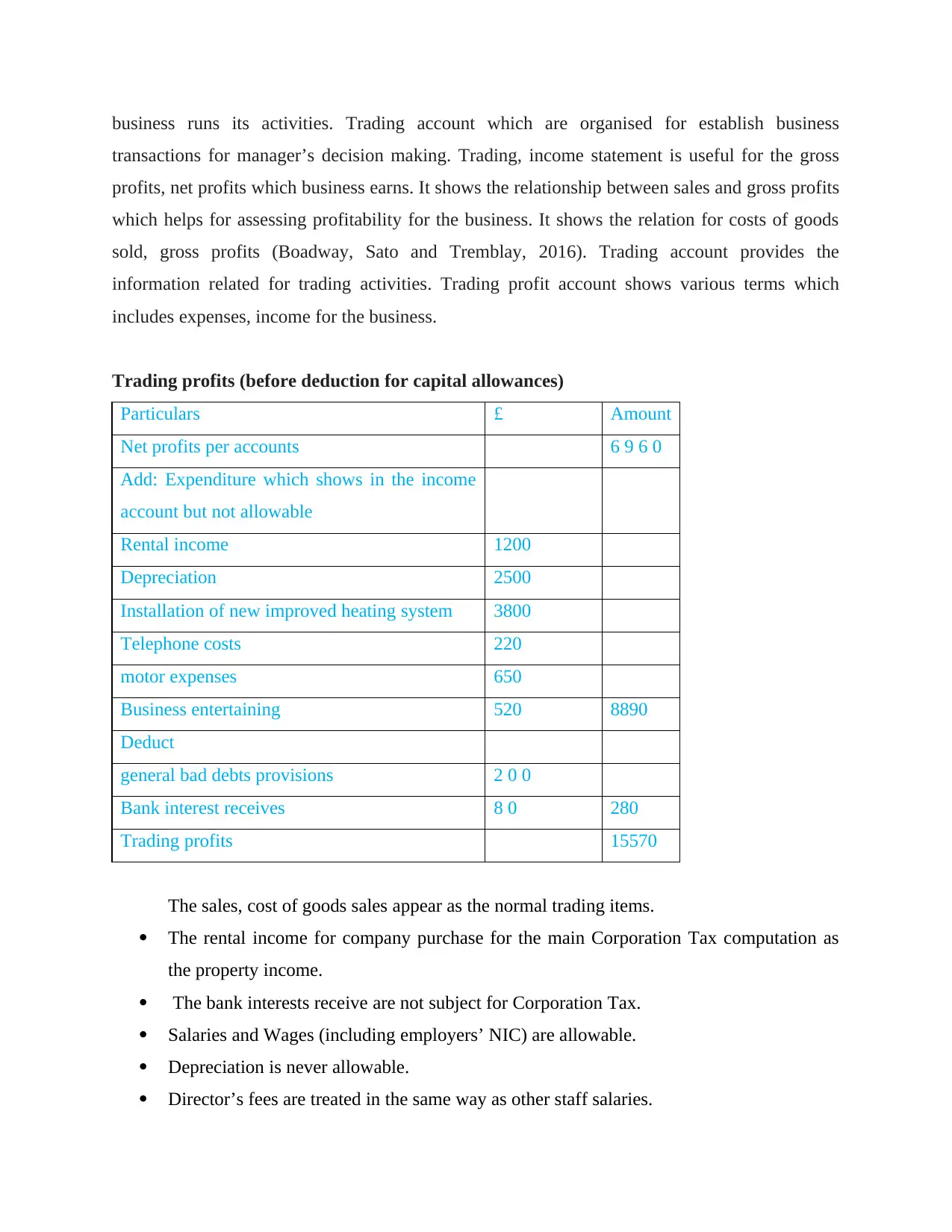
business runs its activities. Trading account which are organised for establish business
transactions for manager’s decision making. Trading, income statement is useful for the gross
profits, net profits which business earns. It shows the relationship between sales and gross profits
which helps for assessing profitability for the business. It shows the relation for costs of goods
sold, gross profits (Boadway, Sato and Tremblay, 2016). Trading account provides the
information related for trading activities. Trading profit account shows various terms which
includes expenses, income for the business.
Trading profits (before deduction for capital allowances)
Particulars £ Amount
Net profits per accounts 6 9 6 0
Add: Expenditure which shows in the income
account but not allowable
Rental income 1200
Depreciation 2500
Installation of new improved heating system 3800
Telephone costs 220
motor expenses 650
Business entertaining 520 8890
Deduct
general bad debts provisions 2 0 0
Bank interest receives 8 0 280
Trading profits 15570
The sales, cost of goods sales appear as the normal trading items.
The rental income for company purchase for the main Corporation Tax computation as
the property income.
The bank interests receive are not subject for Corporation Tax.
Salaries and Wages (including employers’ NIC) are allowable.
Depreciation is never allowable.
Director’s fees are treated in the same way as other staff salaries.
transactions for manager’s decision making. Trading, income statement is useful for the gross
profits, net profits which business earns. It shows the relationship between sales and gross profits
which helps for assessing profitability for the business. It shows the relation for costs of goods
sold, gross profits (Boadway, Sato and Tremblay, 2016). Trading account provides the
information related for trading activities. Trading profit account shows various terms which
includes expenses, income for the business.
Trading profits (before deduction for capital allowances)
Particulars £ Amount
Net profits per accounts 6 9 6 0
Add: Expenditure which shows in the income
account but not allowable
Rental income 1200
Depreciation 2500
Installation of new improved heating system 3800
Telephone costs 220
motor expenses 650
Business entertaining 520 8890
Deduct
general bad debts provisions 2 0 0
Bank interest receives 8 0 280
Trading profits 15570
The sales, cost of goods sales appear as the normal trading items.
The rental income for company purchase for the main Corporation Tax computation as
the property income.
The bank interests receive are not subject for Corporation Tax.
Salaries and Wages (including employers’ NIC) are allowable.
Depreciation is never allowable.
Director’s fees are treated in the same way as other staff salaries.
Secure Best Marks with AI Grader
Need help grading? Try our AI Grader for instant feedback on your assignments.
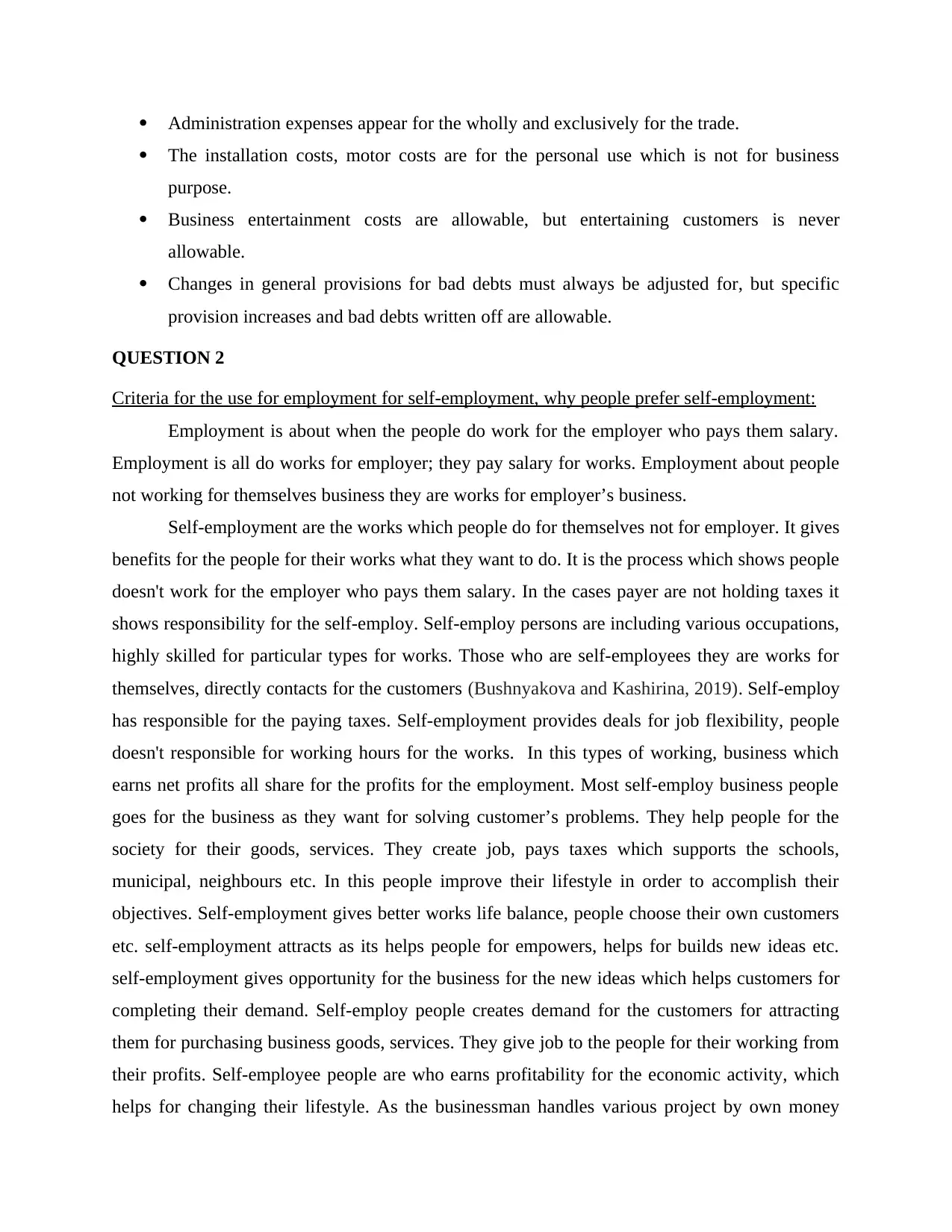
Administration expenses appear for the wholly and exclusively for the trade.
The installation costs, motor costs are for the personal use which is not for business
purpose.
Business entertainment costs are allowable, but entertaining customers is never
allowable.
Changes in general provisions for bad debts must always be adjusted for, but specific
provision increases and bad debts written off are allowable.
QUESTION 2
Criteria for the use for employment for self-employment, why people prefer self-employment:
Employment is about when the people do work for the employer who pays them salary.
Employment is all do works for employer; they pay salary for works. Employment about people
not working for themselves business they are works for employer’s business.
Self-employment are the works which people do for themselves not for employer. It gives
benefits for the people for their works what they want to do. It is the process which shows people
doesn't work for the employer who pays them salary. In the cases payer are not holding taxes it
shows responsibility for the self-employ. Self-employ persons are including various occupations,
highly skilled for particular types for works. Those who are self-employees they are works for
themselves, directly contacts for the customers (Bushnyakova and Kashirina, 2019). Self-employ
has responsible for the paying taxes. Self-employment provides deals for job flexibility, people
doesn't responsible for working hours for the works. In this types of working, business which
earns net profits all share for the profits for the employment. Most self-employ business people
goes for the business as they want for solving customer’s problems. They help people for the
society for their goods, services. They create job, pays taxes which supports the schools,
municipal, neighbours etc. In this people improve their lifestyle in order to accomplish their
objectives. Self-employment gives better works life balance, people choose their own customers
etc. self-employment attracts as its helps people for empowers, helps for builds new ideas etc.
self-employment gives opportunity for the business for the new ideas which helps customers for
completing their demand. Self-employ people creates demand for the customers for attracting
them for purchasing business goods, services. They give job to the people for their working from
their profits. Self-employee people are who earns profitability for the economic activity, which
helps for changing their lifestyle. As the businessman handles various project by own money
The installation costs, motor costs are for the personal use which is not for business
purpose.
Business entertainment costs are allowable, but entertaining customers is never
allowable.
Changes in general provisions for bad debts must always be adjusted for, but specific
provision increases and bad debts written off are allowable.
QUESTION 2
Criteria for the use for employment for self-employment, why people prefer self-employment:
Employment is about when the people do work for the employer who pays them salary.
Employment is all do works for employer; they pay salary for works. Employment about people
not working for themselves business they are works for employer’s business.
Self-employment are the works which people do for themselves not for employer. It gives
benefits for the people for their works what they want to do. It is the process which shows people
doesn't work for the employer who pays them salary. In the cases payer are not holding taxes it
shows responsibility for the self-employ. Self-employ persons are including various occupations,
highly skilled for particular types for works. Those who are self-employees they are works for
themselves, directly contacts for the customers (Bushnyakova and Kashirina, 2019). Self-employ
has responsible for the paying taxes. Self-employment provides deals for job flexibility, people
doesn't responsible for working hours for the works. In this types of working, business which
earns net profits all share for the profits for the employment. Most self-employ business people
goes for the business as they want for solving customer’s problems. They help people for the
society for their goods, services. They create job, pays taxes which supports the schools,
municipal, neighbours etc. In this people improve their lifestyle in order to accomplish their
objectives. Self-employment gives better works life balance, people choose their own customers
etc. self-employment attracts as its helps people for empowers, helps for builds new ideas etc.
self-employment gives opportunity for the business for the new ideas which helps customers for
completing their demand. Self-employ people creates demand for the customers for attracting
them for purchasing business goods, services. They give job to the people for their working from
their profits. Self-employee people are who earns profitability for the economic activity, which
helps for changing their lifestyle. As the businessman handles various project by own money
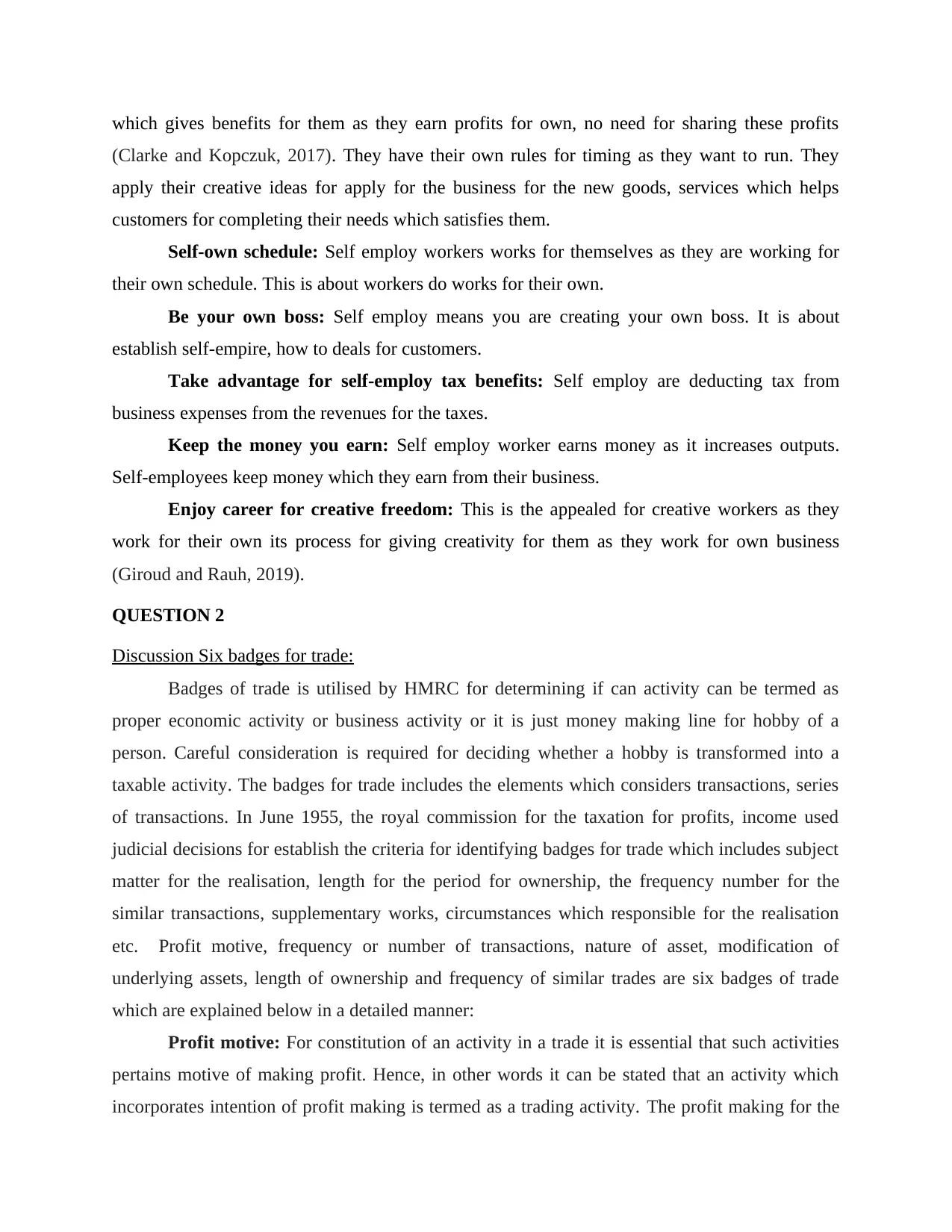
which gives benefits for them as they earn profits for own, no need for sharing these profits
(Clarke and Kopczuk, 2017). They have their own rules for timing as they want to run. They
apply their creative ideas for apply for the business for the new goods, services which helps
customers for completing their needs which satisfies them.
Self-own schedule: Self employ workers works for themselves as they are working for
their own schedule. This is about workers do works for their own.
Be your own boss: Self employ means you are creating your own boss. It is about
establish self-empire, how to deals for customers.
Take advantage for self-employ tax benefits: Self employ are deducting tax from
business expenses from the revenues for the taxes.
Keep the money you earn: Self employ worker earns money as it increases outputs.
Self-employees keep money which they earn from their business.
Enjoy career for creative freedom: This is the appealed for creative workers as they
work for their own its process for giving creativity for them as they work for own business
(Giroud and Rauh, 2019).
QUESTION 2
Discussion Six badges for trade:
Badges of trade is utilised by HMRC for determining if can activity can be termed as
proper economic activity or business activity or it is just money making line for hobby of a
person. Careful consideration is required for deciding whether a hobby is transformed into a
taxable activity. The badges for trade includes the elements which considers transactions, series
of transactions. In June 1955, the royal commission for the taxation for profits, income used
judicial decisions for establish the criteria for identifying badges for trade which includes subject
matter for the realisation, length for the period for ownership, the frequency number for the
similar transactions, supplementary works, circumstances which responsible for the realisation
etc. Profit motive, frequency or number of transactions, nature of asset, modification of
underlying assets, length of ownership and frequency of similar trades are six badges of trade
which are explained below in a detailed manner:
Profit motive: For constitution of an activity in a trade it is essential that such activities
pertains motive of making profit. Hence, in other words it can be stated that an activity which
incorporates intention of profit making is termed as a trading activity. The profit making for the
(Clarke and Kopczuk, 2017). They have their own rules for timing as they want to run. They
apply their creative ideas for apply for the business for the new goods, services which helps
customers for completing their needs which satisfies them.
Self-own schedule: Self employ workers works for themselves as they are working for
their own schedule. This is about workers do works for their own.
Be your own boss: Self employ means you are creating your own boss. It is about
establish self-empire, how to deals for customers.
Take advantage for self-employ tax benefits: Self employ are deducting tax from
business expenses from the revenues for the taxes.
Keep the money you earn: Self employ worker earns money as it increases outputs.
Self-employees keep money which they earn from their business.
Enjoy career for creative freedom: This is the appealed for creative workers as they
work for their own its process for giving creativity for them as they work for own business
(Giroud and Rauh, 2019).
QUESTION 2
Discussion Six badges for trade:
Badges of trade is utilised by HMRC for determining if can activity can be termed as
proper economic activity or business activity or it is just money making line for hobby of a
person. Careful consideration is required for deciding whether a hobby is transformed into a
taxable activity. The badges for trade includes the elements which considers transactions, series
of transactions. In June 1955, the royal commission for the taxation for profits, income used
judicial decisions for establish the criteria for identifying badges for trade which includes subject
matter for the realisation, length for the period for ownership, the frequency number for the
similar transactions, supplementary works, circumstances which responsible for the realisation
etc. Profit motive, frequency or number of transactions, nature of asset, modification of
underlying assets, length of ownership and frequency of similar trades are six badges of trade
which are explained below in a detailed manner:
Profit motive: For constitution of an activity in a trade it is essential that such activities
pertains motive of making profit. Hence, in other words it can be stated that an activity which
incorporates intention of profit making is termed as a trading activity. The profit making for the
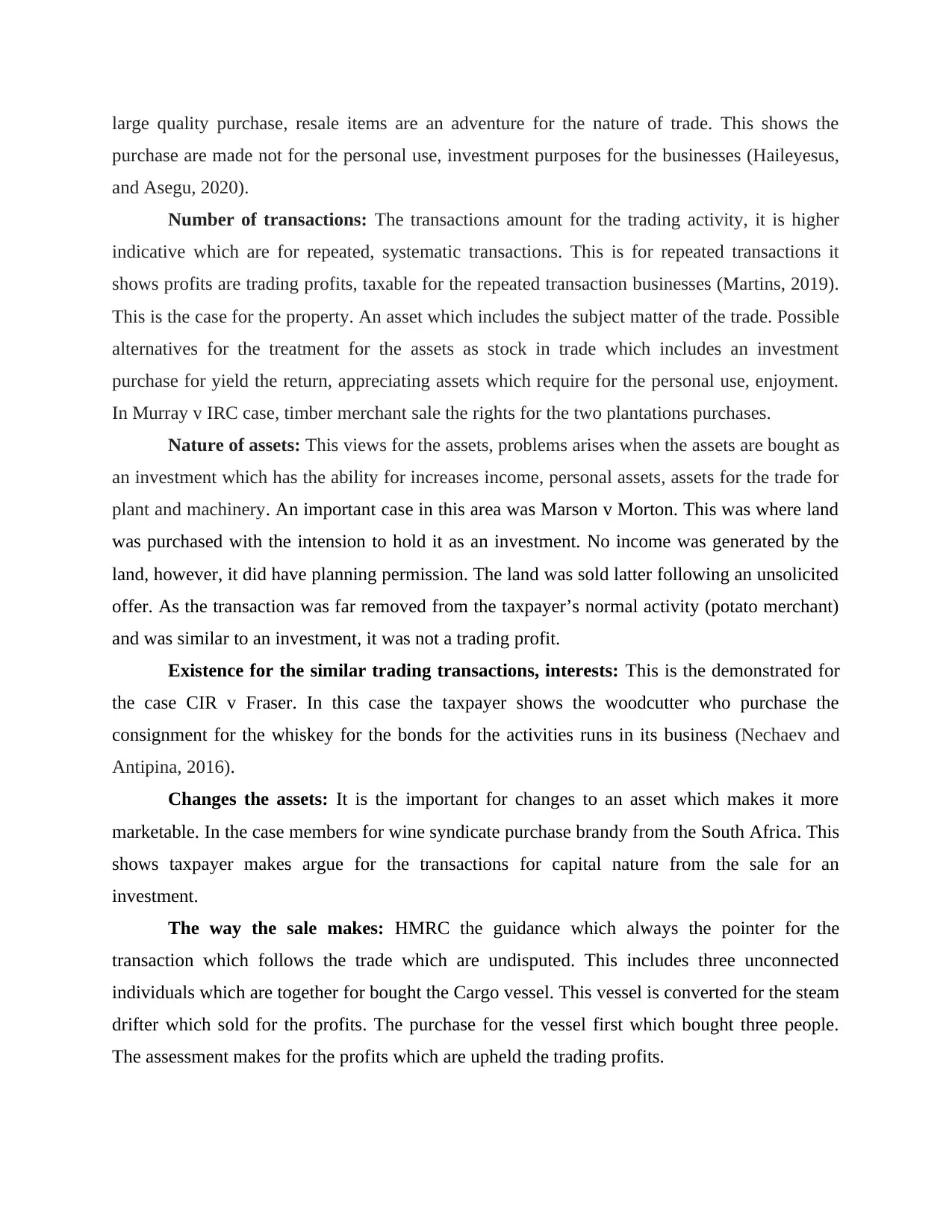
large quality purchase, resale items are an adventure for the nature of trade. This shows the
purchase are made not for the personal use, investment purposes for the businesses (Haileyesus,
and Asegu, 2020).
Number of transactions: The transactions amount for the trading activity, it is higher
indicative which are for repeated, systematic transactions. This is for repeated transactions it
shows profits are trading profits, taxable for the repeated transaction businesses (Martins, 2019).
This is the case for the property. An asset which includes the subject matter of the trade. Possible
alternatives for the treatment for the assets as stock in trade which includes an investment
purchase for yield the return, appreciating assets which require for the personal use, enjoyment.
In Murray v IRC case, timber merchant sale the rights for the two plantations purchases.
Nature of assets: This views for the assets, problems arises when the assets are bought as
an investment which has the ability for increases income, personal assets, assets for the trade for
plant and machinery. An important case in this area was Marson v Morton. This was where land
was purchased with the intension to hold it as an investment. No income was generated by the
land, however, it did have planning permission. The land was sold latter following an unsolicited
offer. As the transaction was far removed from the taxpayer’s normal activity (potato merchant)
and was similar to an investment, it was not a trading profit.
Existence for the similar trading transactions, interests: This is the demonstrated for
the case CIR v Fraser. In this case the taxpayer shows the woodcutter who purchase the
consignment for the whiskey for the bonds for the activities runs in its business (Nechaev and
Antipina, 2016).
Changes the assets: It is the important for changes to an asset which makes it more
marketable. In the case members for wine syndicate purchase brandy from the South Africa. This
shows taxpayer makes argue for the transactions for capital nature from the sale for an
investment.
The way the sale makes: HMRC the guidance which always the pointer for the
transaction which follows the trade which are undisputed. This includes three unconnected
individuals which are together for bought the Cargo vessel. This vessel is converted for the steam
drifter which sold for the profits. The purchase for the vessel first which bought three people.
The assessment makes for the profits which are upheld the trading profits.
purchase are made not for the personal use, investment purposes for the businesses (Haileyesus,
and Asegu, 2020).
Number of transactions: The transactions amount for the trading activity, it is higher
indicative which are for repeated, systematic transactions. This is for repeated transactions it
shows profits are trading profits, taxable for the repeated transaction businesses (Martins, 2019).
This is the case for the property. An asset which includes the subject matter of the trade. Possible
alternatives for the treatment for the assets as stock in trade which includes an investment
purchase for yield the return, appreciating assets which require for the personal use, enjoyment.
In Murray v IRC case, timber merchant sale the rights for the two plantations purchases.
Nature of assets: This views for the assets, problems arises when the assets are bought as
an investment which has the ability for increases income, personal assets, assets for the trade for
plant and machinery. An important case in this area was Marson v Morton. This was where land
was purchased with the intension to hold it as an investment. No income was generated by the
land, however, it did have planning permission. The land was sold latter following an unsolicited
offer. As the transaction was far removed from the taxpayer’s normal activity (potato merchant)
and was similar to an investment, it was not a trading profit.
Existence for the similar trading transactions, interests: This is the demonstrated for
the case CIR v Fraser. In this case the taxpayer shows the woodcutter who purchase the
consignment for the whiskey for the bonds for the activities runs in its business (Nechaev and
Antipina, 2016).
Changes the assets: It is the important for changes to an asset which makes it more
marketable. In the case members for wine syndicate purchase brandy from the South Africa. This
shows taxpayer makes argue for the transactions for capital nature from the sale for an
investment.
The way the sale makes: HMRC the guidance which always the pointer for the
transaction which follows the trade which are undisputed. This includes three unconnected
individuals which are together for bought the Cargo vessel. This vessel is converted for the steam
drifter which sold for the profits. The purchase for the vessel first which bought three people.
The assessment makes for the profits which are upheld the trading profits.
Paraphrase This Document
Need a fresh take? Get an instant paraphrase of this document with our AI Paraphraser
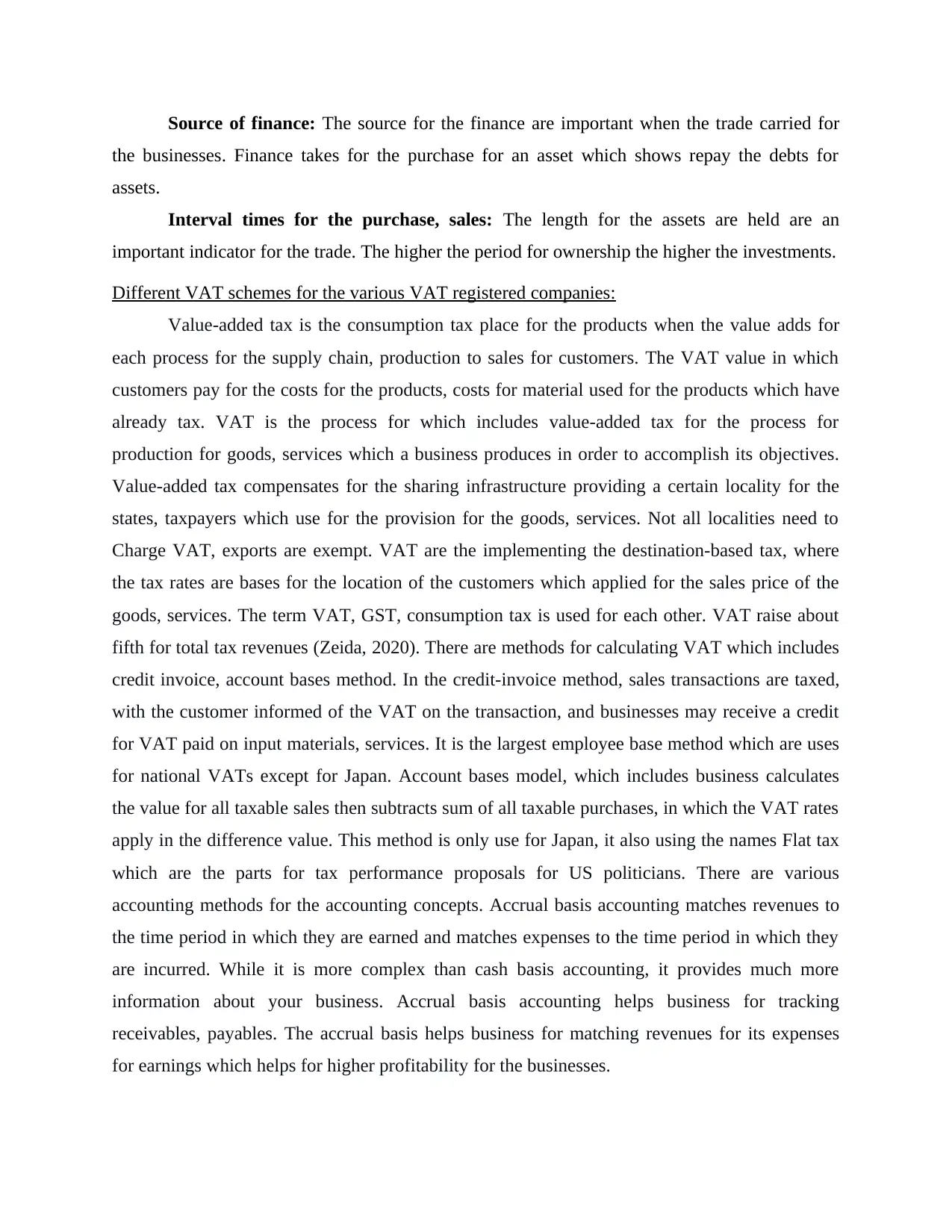
Source of finance: The source for the finance are important when the trade carried for
the businesses. Finance takes for the purchase for an asset which shows repay the debts for
assets.
Interval times for the purchase, sales: The length for the assets are held are an
important indicator for the trade. The higher the period for ownership the higher the investments.
Different VAT schemes for the various VAT registered companies:
Value-added tax is the consumption tax place for the products when the value adds for
each process for the supply chain, production to sales for customers. The VAT value in which
customers pay for the costs for the products, costs for material used for the products which have
already tax. VAT is the process for which includes value-added tax for the process for
production for goods, services which a business produces in order to accomplish its objectives.
Value-added tax compensates for the sharing infrastructure providing a certain locality for the
states, taxpayers which use for the provision for the goods, services. Not all localities need to
Charge VAT, exports are exempt. VAT are the implementing the destination-based tax, where
the tax rates are bases for the location of the customers which applied for the sales price of the
goods, services. The term VAT, GST, consumption tax is used for each other. VAT raise about
fifth for total tax revenues (Zeida, 2020). There are methods for calculating VAT which includes
credit invoice, account bases method. In the credit-invoice method, sales transactions are taxed,
with the customer informed of the VAT on the transaction, and businesses may receive a credit
for VAT paid on input materials, services. It is the largest employee base method which are uses
for national VATs except for Japan. Account bases model, which includes business calculates
the value for all taxable sales then subtracts sum of all taxable purchases, in which the VAT rates
apply in the difference value. This method is only use for Japan, it also using the names Flat tax
which are the parts for tax performance proposals for US politicians. There are various
accounting methods for the accounting concepts. Accrual basis accounting matches revenues to
the time period in which they are earned and matches expenses to the time period in which they
are incurred. While it is more complex than cash basis accounting, it provides much more
information about your business. Accrual basis accounting helps business for tracking
receivables, payables. The accrual basis helps business for matching revenues for its expenses
for earnings which helps for higher profitability for the businesses.
the businesses. Finance takes for the purchase for an asset which shows repay the debts for
assets.
Interval times for the purchase, sales: The length for the assets are held are an
important indicator for the trade. The higher the period for ownership the higher the investments.
Different VAT schemes for the various VAT registered companies:
Value-added tax is the consumption tax place for the products when the value adds for
each process for the supply chain, production to sales for customers. The VAT value in which
customers pay for the costs for the products, costs for material used for the products which have
already tax. VAT is the process for which includes value-added tax for the process for
production for goods, services which a business produces in order to accomplish its objectives.
Value-added tax compensates for the sharing infrastructure providing a certain locality for the
states, taxpayers which use for the provision for the goods, services. Not all localities need to
Charge VAT, exports are exempt. VAT are the implementing the destination-based tax, where
the tax rates are bases for the location of the customers which applied for the sales price of the
goods, services. The term VAT, GST, consumption tax is used for each other. VAT raise about
fifth for total tax revenues (Zeida, 2020). There are methods for calculating VAT which includes
credit invoice, account bases method. In the credit-invoice method, sales transactions are taxed,
with the customer informed of the VAT on the transaction, and businesses may receive a credit
for VAT paid on input materials, services. It is the largest employee base method which are uses
for national VATs except for Japan. Account bases model, which includes business calculates
the value for all taxable sales then subtracts sum of all taxable purchases, in which the VAT rates
apply in the difference value. This method is only use for Japan, it also using the names Flat tax
which are the parts for tax performance proposals for US politicians. There are various
accounting methods for the accounting concepts. Accrual basis accounting matches revenues to
the time period in which they are earned and matches expenses to the time period in which they
are incurred. While it is more complex than cash basis accounting, it provides much more
information about your business. Accrual basis accounting helps business for tracking
receivables, payables. The accrual basis helps business for matching revenues for its expenses
for earnings which helps for higher profitability for the businesses.
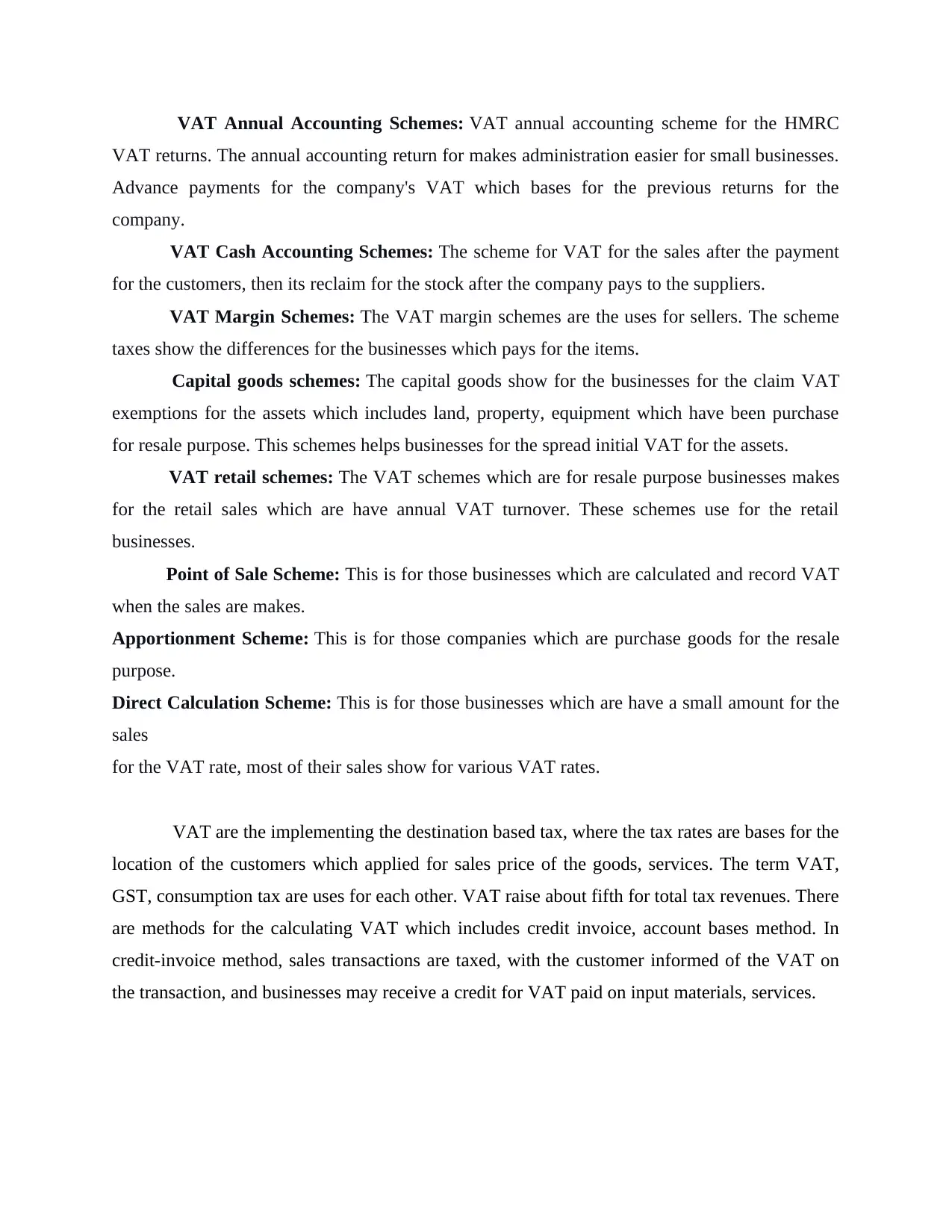
VAT Annual Accounting Schemes: VAT annual accounting scheme for the HMRC
VAT returns. The annual accounting return for makes administration easier for small businesses.
Advance payments for the company's VAT which bases for the previous returns for the
company.
VAT Cash Accounting Schemes: The scheme for VAT for the sales after the payment
for the customers, then its reclaim for the stock after the company pays to the suppliers.
VAT Margin Schemes: The VAT margin schemes are the uses for sellers. The scheme
taxes show the differences for the businesses which pays for the items.
Capital goods schemes: The capital goods show for the businesses for the claim VAT
exemptions for the assets which includes land, property, equipment which have been purchase
for resale purpose. This schemes helps businesses for the spread initial VAT for the assets.
VAT retail schemes: The VAT schemes which are for resale purpose businesses makes
for the retail sales which are have annual VAT turnover. These schemes use for the retail
businesses.
Point of Sale Scheme: This is for those businesses which are calculated and record VAT
when the sales are makes.
Apportionment Scheme: This is for those companies which are purchase goods for the resale
purpose.
Direct Calculation Scheme: This is for those businesses which are have a small amount for the
sales
for the VAT rate, most of their sales show for various VAT rates.
VAT are the implementing the destination based tax, where the tax rates are bases for the
location of the customers which applied for sales price of the goods, services. The term VAT,
GST, consumption tax are uses for each other. VAT raise about fifth for total tax revenues. There
are methods for the calculating VAT which includes credit invoice, account bases method. In
credit-invoice method, sales transactions are taxed, with the customer informed of the VAT on
the transaction, and businesses may receive a credit for VAT paid on input materials, services.
VAT returns. The annual accounting return for makes administration easier for small businesses.
Advance payments for the company's VAT which bases for the previous returns for the
company.
VAT Cash Accounting Schemes: The scheme for VAT for the sales after the payment
for the customers, then its reclaim for the stock after the company pays to the suppliers.
VAT Margin Schemes: The VAT margin schemes are the uses for sellers. The scheme
taxes show the differences for the businesses which pays for the items.
Capital goods schemes: The capital goods show for the businesses for the claim VAT
exemptions for the assets which includes land, property, equipment which have been purchase
for resale purpose. This schemes helps businesses for the spread initial VAT for the assets.
VAT retail schemes: The VAT schemes which are for resale purpose businesses makes
for the retail sales which are have annual VAT turnover. These schemes use for the retail
businesses.
Point of Sale Scheme: This is for those businesses which are calculated and record VAT
when the sales are makes.
Apportionment Scheme: This is for those companies which are purchase goods for the resale
purpose.
Direct Calculation Scheme: This is for those businesses which are have a small amount for the
sales
for the VAT rate, most of their sales show for various VAT rates.
VAT are the implementing the destination based tax, where the tax rates are bases for the
location of the customers which applied for sales price of the goods, services. The term VAT,
GST, consumption tax are uses for each other. VAT raise about fifth for total tax revenues. There
are methods for the calculating VAT which includes credit invoice, account bases method. In
credit-invoice method, sales transactions are taxed, with the customer informed of the VAT on
the transaction, and businesses may receive a credit for VAT paid on input materials, services.
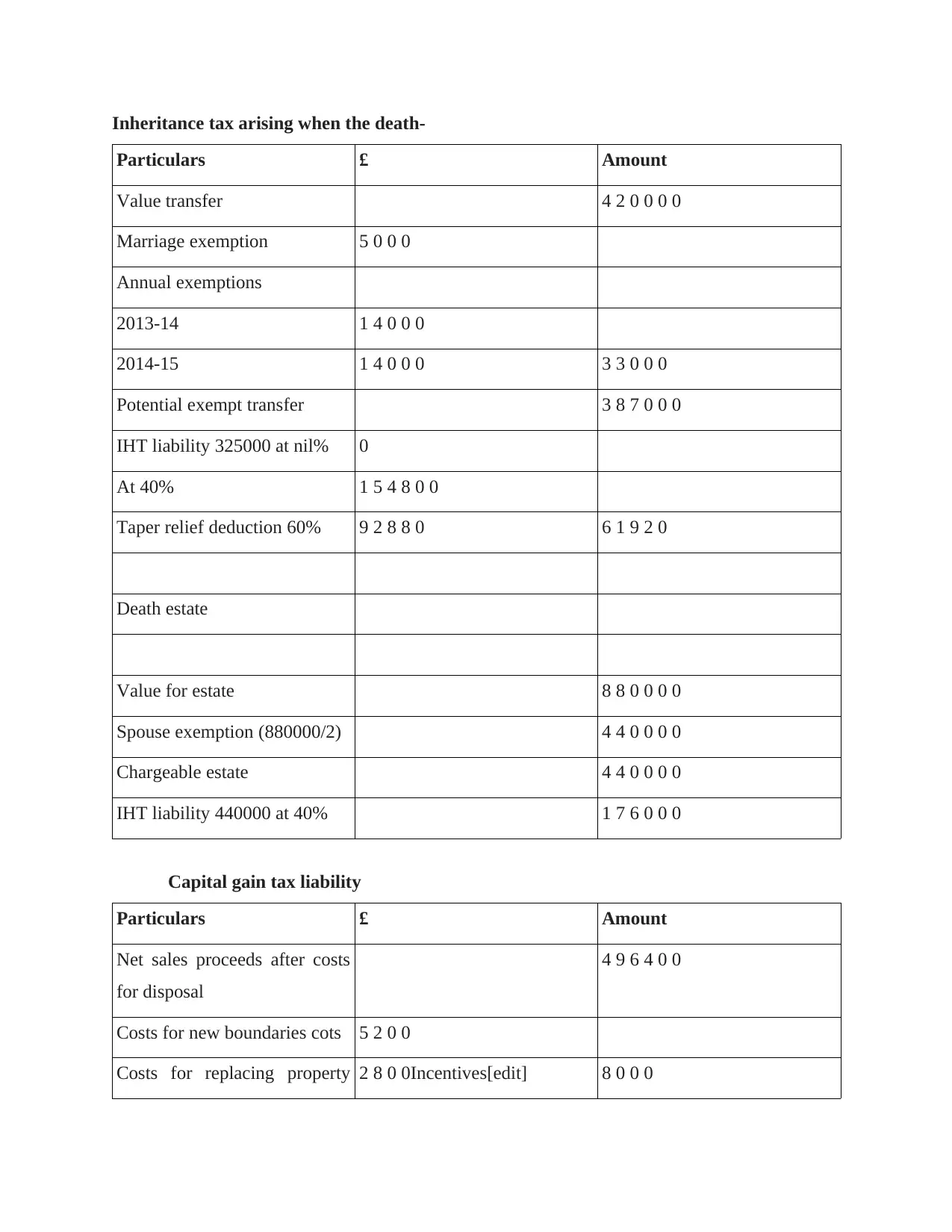
Inheritance tax arising when the death-
Particulars £ Amount
Value transfer 4 2 0 0 0 0
Marriage exemption 5 0 0 0
Annual exemptions
2013-14 1 4 0 0 0
2014-15 1 4 0 0 0 3 3 0 0 0
Potential exempt transfer 3 8 7 0 0 0
IHT liability 325000 at nil% 0
At 40% 1 5 4 8 0 0
Taper relief deduction 60% 9 2 8 8 0 6 1 9 2 0
Death estate
Value for estate 8 8 0 0 0 0
Spouse exemption (880000/2) 4 4 0 0 0 0
Chargeable estate 4 4 0 0 0 0
IHT liability 440000 at 40% 1 7 6 0 0 0
Capital gain tax liability
Particulars £ Amount
Net sales proceeds after costs
for disposal
4 9 6 4 0 0
Costs for new boundaries cots 5 2 0 0
Costs for replacing property 2 8 0 0Incentives[edit] 8 0 0 0
Particulars £ Amount
Value transfer 4 2 0 0 0 0
Marriage exemption 5 0 0 0
Annual exemptions
2013-14 1 4 0 0 0
2014-15 1 4 0 0 0 3 3 0 0 0
Potential exempt transfer 3 8 7 0 0 0
IHT liability 325000 at nil% 0
At 40% 1 5 4 8 0 0
Taper relief deduction 60% 9 2 8 8 0 6 1 9 2 0
Death estate
Value for estate 8 8 0 0 0 0
Spouse exemption (880000/2) 4 4 0 0 0 0
Chargeable estate 4 4 0 0 0 0
IHT liability 440000 at 40% 1 7 6 0 0 0
Capital gain tax liability
Particulars £ Amount
Net sales proceeds after costs
for disposal
4 9 6 4 0 0
Costs for new boundaries cots 5 2 0 0
Costs for replacing property 2 8 0 0Incentives[edit] 8 0 0 0
Secure Best Marks with AI Grader
Need help grading? Try our AI Grader for instant feedback on your assignments.
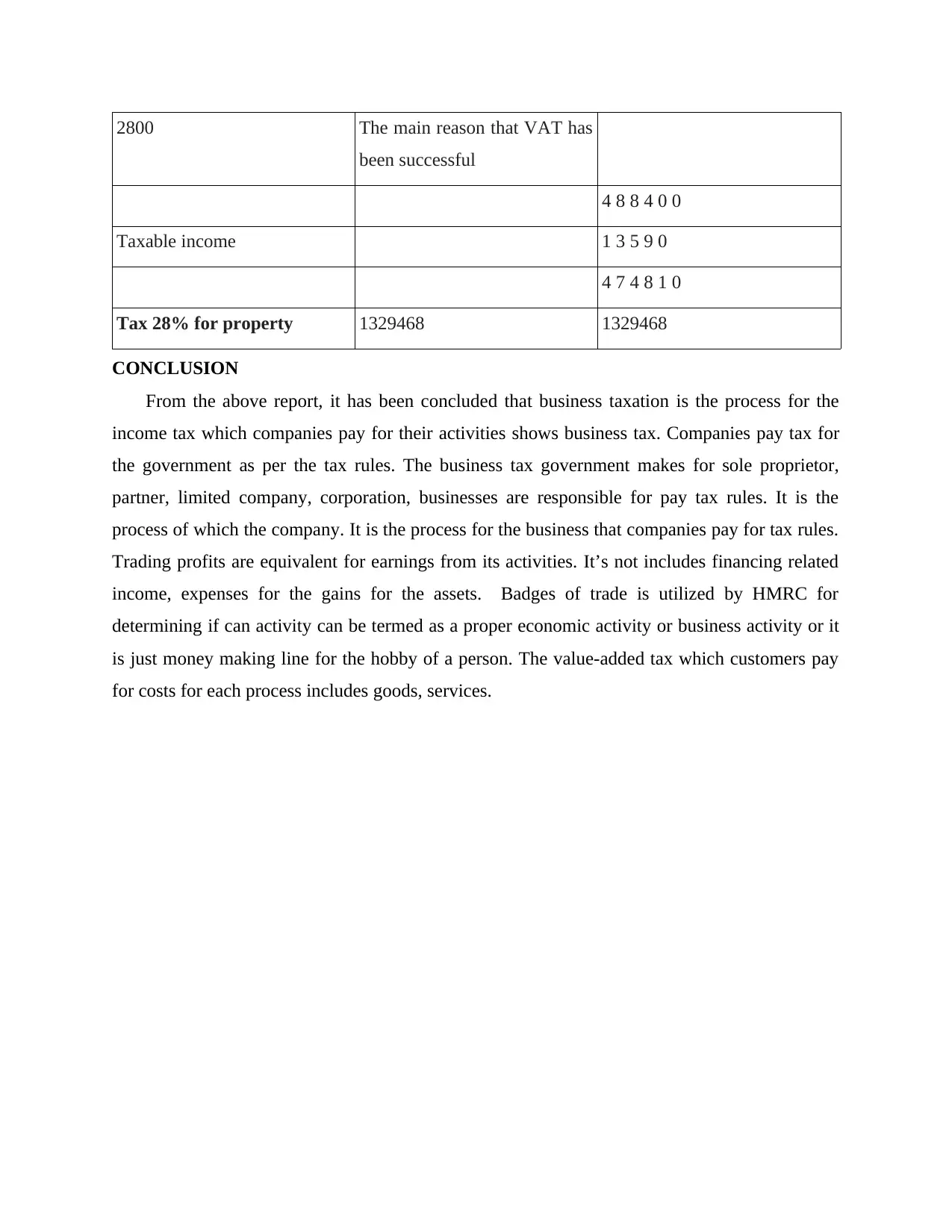
2800 The main reason that VAT has
been successful
4 8 8 4 0 0
Taxable income 1 3 5 9 0
4 7 4 8 1 0
Tax 28% for property 1329468 1329468
CONCLUSION
From the above report, it has been concluded that business taxation is the process for the
income tax which companies pay for their activities shows business tax. Companies pay tax for
the government as per the tax rules. The business tax government makes for sole proprietor,
partner, limited company, corporation, businesses are responsible for pay tax rules. It is the
process of which the company. It is the process for the business that companies pay for tax rules.
Trading profits are equivalent for earnings from its activities. It’s not includes financing related
income, expenses for the gains for the assets. Badges of trade is utilized by HMRC for
determining if can activity can be termed as a proper economic activity or business activity or it
is just money making line for the hobby of a person. The value-added tax which customers pay
for costs for each process includes goods, services.
been successful
4 8 8 4 0 0
Taxable income 1 3 5 9 0
4 7 4 8 1 0
Tax 28% for property 1329468 1329468
CONCLUSION
From the above report, it has been concluded that business taxation is the process for the
income tax which companies pay for their activities shows business tax. Companies pay tax for
the government as per the tax rules. The business tax government makes for sole proprietor,
partner, limited company, corporation, businesses are responsible for pay tax rules. It is the
process of which the company. It is the process for the business that companies pay for tax rules.
Trading profits are equivalent for earnings from its activities. It’s not includes financing related
income, expenses for the gains for the assets. Badges of trade is utilized by HMRC for
determining if can activity can be termed as a proper economic activity or business activity or it
is just money making line for the hobby of a person. The value-added tax which customers pay
for costs for each process includes goods, services.

REFERENCES
Books and journals:
Al Karaawy, N. A. A. and Al Baaj, Q. M. A., 2018. Taxation of international business
organizations. Academy of Accounting and Financial Studies Journal. 22(1). pp.1-16.
Arnold, B. J., Ault, H. J. and Cooper, G. eds., 2019. Comparative income taxation: a structural
analysis. Kluwer Law International BV.
Biddle, N., Fels, K. M. and Sinning, M., 2018. Behavioral insights on business taxation:
Evidence from two natural field experiments. Journal of Behavioral and Experimental
Finance. 18. pp.30-49.
Blakeley, G., 2018. Fair dues: Rebalancing business taxation in the UK.
Boadway, R. W., Sato, M. and Tremblay, J. F., 2016. Cash-flow business taxation revisited:
Bankruptcy, risk aversion and asymmetric information (No. 1372). Queen's Economics
Department Working Paper.
Bushnyakova, A. I. and Kashirina, M. V., 2019. Some features of small business taxation (on the
example of construction). In Наука и образование в социокультурном пространстве
современного общества (pp. 60-64).
Clarke, C. and Kopczuk, W., 2017. Business income and business taxation in the United States
since the 1950s. Tax Policy and the Economy. 31(1). pp.121-159.
Giroud, X. and Rauh, J., 2019. State taxation and the reallocation of business activity: Evidence
from establishment-level data. Journal of Political Economy. 127(3). pp.1262-1316.
Haileyesus, I. W. and Asegu, E. K., 2020. Small Business Taxation in Ethiopia: A Focus on
Legal and Practical Issues in Income Tax Category. Journal of Taxation and Regulatory
Framework. 3(1).
Martins, A., 2019. Country Note: Three Emblematic Measures in Portuguese Business Taxation:
A Preliminary Quantitative Appraisal. Intertax. 47(6/7).
Nechaev, A. and Antipina, O., 2016. Analysis of the Impact of Taxation of Business Entities on
the Innovative Development of the Country.
Zeida, T. W. H., 2020. Essays on business taxation.
Books and journals:
Al Karaawy, N. A. A. and Al Baaj, Q. M. A., 2018. Taxation of international business
organizations. Academy of Accounting and Financial Studies Journal. 22(1). pp.1-16.
Arnold, B. J., Ault, H. J. and Cooper, G. eds., 2019. Comparative income taxation: a structural
analysis. Kluwer Law International BV.
Biddle, N., Fels, K. M. and Sinning, M., 2018. Behavioral insights on business taxation:
Evidence from two natural field experiments. Journal of Behavioral and Experimental
Finance. 18. pp.30-49.
Blakeley, G., 2018. Fair dues: Rebalancing business taxation in the UK.
Boadway, R. W., Sato, M. and Tremblay, J. F., 2016. Cash-flow business taxation revisited:
Bankruptcy, risk aversion and asymmetric information (No. 1372). Queen's Economics
Department Working Paper.
Bushnyakova, A. I. and Kashirina, M. V., 2019. Some features of small business taxation (on the
example of construction). In Наука и образование в социокультурном пространстве
современного общества (pp. 60-64).
Clarke, C. and Kopczuk, W., 2017. Business income and business taxation in the United States
since the 1950s. Tax Policy and the Economy. 31(1). pp.121-159.
Giroud, X. and Rauh, J., 2019. State taxation and the reallocation of business activity: Evidence
from establishment-level data. Journal of Political Economy. 127(3). pp.1262-1316.
Haileyesus, I. W. and Asegu, E. K., 2020. Small Business Taxation in Ethiopia: A Focus on
Legal and Practical Issues in Income Tax Category. Journal of Taxation and Regulatory
Framework. 3(1).
Martins, A., 2019. Country Note: Three Emblematic Measures in Portuguese Business Taxation:
A Preliminary Quantitative Appraisal. Intertax. 47(6/7).
Nechaev, A. and Antipina, O., 2016. Analysis of the Impact of Taxation of Business Entities on
the Innovative Development of the Country.
Zeida, T. W. H., 2020. Essays on business taxation.
1 out of 12
Related Documents
Your All-in-One AI-Powered Toolkit for Academic Success.
+13062052269
info@desklib.com
Available 24*7 on WhatsApp / Email
![[object Object]](/_next/static/media/star-bottom.7253800d.svg)
Unlock your academic potential
© 2024 | Zucol Services PVT LTD | All rights reserved.





